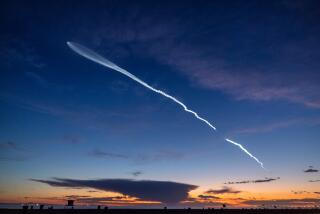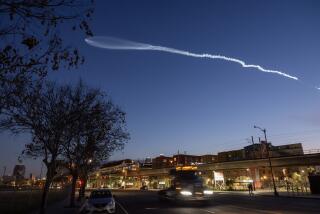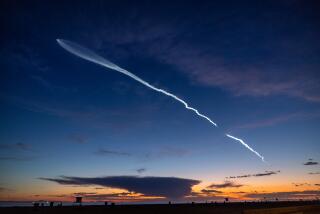Sees Latest Rocket : Weinberger Tours China Space Port
- Share via
XICHANG, China — Defense Secretary Caspar W. Weinberger was given a rare tour of a Chinese space complex and launch site here Friday as well as a close-up look at the Long March 3, believed to be the nation’s latest rocket.
Because the U.S. space effort has been set back sharply by the Challenger disaster, China hopes to put American commercial satellites into orbit in the months ahead. After his tour of the complex, Weinberger told reporters, “It’s clearly capable of making the launches.”
He said that next year, after the Chinese carry out their plans for extensive improvements at the facility here in Sichuan province, it will be “extremely capable.”
The Xichang launch site, which Weinberger reached after a flight on a Chinese airliner and then an hour’s drive past settlements of brick and packed-mud houses, rice paddies and grazing water buffalo, is believed to be one of two in this country. The other, which is thought to be used by the military, is in Gansu province, several hundred miles north of here, a Chinese army officer said Friday.
In Mountainous Region
The installation here is set in a mountainous region about 1,200 miles southwest of Peking that resembles a scene from the 19th Century. Pigs root through a nearby rice paddy, and peasants walk barefoot along the irrigation ditches.
As Weinberger’s entourage drove past, women in the white turbans worn by the Yi people, one of China’s many ethnic minorities, looked up from their work. The water buffalo did not.
Workers at the space center are reminded constantly of the fledgling nature of the Chinese space program. A sign on a wall overlooking the launch pad says, in giant red characters, “Although we are at the bottom, we are aiming for the top.”
The Chinese are clearly interested in launching American satellites, as are some U.S. officials whose goals are to further Washington’s ties with Peking in the economic field as well as the military. For the Chinese, putting up American commercial satellites would bring in needed dollars.
The Chinese have already launched satellites for other non-Chinese interests, and “they are making serious proposals” for more launchings, a State Department official said Friday. He said the U.S. government has made it clear that it has no objection, but Chinese negotiations with private American companies have not been completed.
Before Weinberger left Washington, a U.S. official there said that the U.S. government believes the Chinese are “very interested in trying to meet our concerns in launching American satellites.” He said Washington in general has no concern about China’s launching the spacecraft, “providing our national security concerns can be met.” To accomplish this, the United States would need complete control over the satellite from its arrival in China until it is launched.
Western Union Signed
Of the American companies that operate satellites, only Western Union has signed a letter of intent to use the Chinese facility, the State Department official here said. However, he added, a specific agreement on the terms of the launch has not been reached.
The Chinese effort to obtain private customers for the Long March 3, named after the Communist forces’ retreat into the interior in the 1930s during their civil war with the Nationalists, is being given greater attention since the explosion of the space shuttle Challenger last January and the resulting delay of further shuttle flights.
Although the Reagan Administration has given its go-ahead to the development of a commercial rocket-launching industry in the United States, no such operations are expected for several years.
Resembles Houston Center
The launch control facility Weinberger visited resembles at least superficially the Houston Mission Control center used for American space flights. An instrument panel more than 50 feet long faces a digital display board two stories high and marked, naturally, with Chinese characters.
The launch pad, planned in 1975 and built several years later, has been used for two Long March 3 launchings in 1984 and another this year, an army officer said.
Although at least one senior official of the National Aeronautics and Space Administration had previously visited the site, according to a U.S. Embassy official who traveled here with Weinberger, it is a rare stop on the itinerary of American officials in China.
U.S. officials said American reporters had not previously been allowed to tour the facility.
More to Read
Sign up for Essential California
The most important California stories and recommendations in your inbox every morning.
You may occasionally receive promotional content from the Los Angeles Times.










